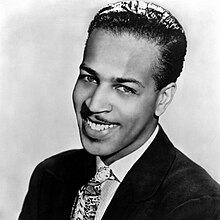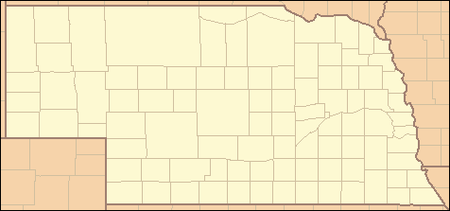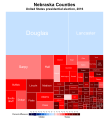The Nebraska Portal
The Flag of Nebraska Nebraska nə-BRASS -kə state in the Midwestern region of the United States . It borders South Dakota to the north; Iowa to the east and Missouri to the southeast, both across the Missouri River ; Kansas to the south; Colorado to the southwest; and Wyoming to the west. Nebraska is the 16th largest state by land area , with just over 77,220 square miles (200,000 km2 ). With a population of over 1.9 million, it is the 37th most populous state and the 7th least densely populated . Its capital is Lincoln , and its most populous city is Omaha , which is on the Missouri River . Nebraska was admitted into the United States in 1867, two years after the end of the American Civil War . The Nebraska Legislature is unlike any other American legislature in that it is unicameral , and its members are elected without any official reference to political party affiliation .
Nebraska is composed of two major land regions: the Dissected Till Plains and the Great Plains . The Dissected Till Plains region consists of gently rolling hills and contains the state's largest cities, Omaha and Lincoln. The Great Plains region, occupying most of western Nebraska, is characterized by treeless prairie . Eastern Nebraska has a humid continental climate while western Nebraska is primarily semi-arid . The state has wide variations between winter and summer temperatures; the variations decrease in southern Nebraska. Violent thunderstorms and tornadoes occur primarily during spring and summer, and sometimes in autumn. Chinook wind tends to warm the state significantly in the winter and early spring.
Indigenous peoples, including Omaha , Missouria , Ponca , Pawnee , Otoe , and various branches of the Lakota (Sioux ) tribes, lived in the region for thousands of years before European discovery and exploration . The state is crossed by many historic trails, including that of the Lewis and Clark Expedition . The completion of the Transcontinental Railroad through Nebraska and passage of the Homestead Acts led to rapid growth in the population of American settlers in the 1870s and 1880s and the development of a large agriculture sector for which the state is known to this day. (Full article...
The cornerstone for the Schoolhouse
Strang School District No. 36 , or the
Strang Public School , is a historic school located in
Fillmore County ,
Nebraska , in the village of
Strang . The school is one of the two sites listed on the
National Register of Historic Places in the village of Strang. The school building is a small, two-story, brick public schoolhouse, which was built to replace the schoolhouse that was previously located on that site. The schoolhouse was built between 1929 and 1930, and replaced the previous schoolhouse, which burned down in 1928. The schoolhouse still retains all original building materials. The school served high school students from 1930 to 1951, and still functions as a school today, serving grades K–8. The NRHP listing also includes a flagpole located outside the schoolhouse, and five pieces of playground equipment. (
Full article... )
List of selected articles
History of Nebraska List of Nebraska state symbols List of counties in Nebraska List of governors of Nebraska Governor of Nebraska Lincoln, Nebraska Omaha, Nebraska Mormon Trail Nebraska (film) African Americans in Omaha, Nebraska Historic Presbyterian Community Center (Madison, Nebraska) Pike-Pawnee Village Site University of Nebraska Omaha Lewis and Clark Lake McCook Gazette Dowse Sod House Lake McConaughy 1990 Nebraska gubernatorial election Nebraska Medicine Warrick house (Meadow Grove, Nebraska) Capital punishment in Nebraska Saint Leonard Catholic Church (Madison, Nebraska) Engineer Cantonment Fontenelle Forest Homestead National Historical Park Ashfall Fossil Beds History of Lincoln, Nebraska Economy of Omaha, Nebraska Berkshire Hathaway Racial tension in Omaha, Nebraska Nebraska Cornhuskers football History of Nebraska Cornhuskers football Battle of Mud Springs COVID-19 pandemic in Nebraska Hartington City Hall and Auditorium Germans in Omaha, Nebraska 2019 Midwestern U.S. floods LGBT rights in Nebraska Union Pacific Corporation Omaha Mavericks men's ice hockey Spade Ranch (Nebraska) North Omaha, Nebraska Rice–Poindexter case Standing Bear Bellevue, Nebraska Grand Island, Nebraska Hastings, Nebraska U.S. Route 385 in Nebraska List of Omaha landmarks Cabela's University of Nebraska–Lincoln Creighton Preparatory School Ogallala Aquifer 2020 United States presidential election in Nebraska 2020 United States Senate election in Nebraska Interstate 180 (Nebraska)
Counties (clickable map)
The following are images from various Nebraska-related articles on Wikipedia.
Image 2 Nebraska in 1718,
Guillaume de L'Isle map, with the approximate area of the future state highlighted (from
Nebraska )
Image 4 Wagon train headed to California (from
History of Nebraska )
Image 5 Nebraska grain bins and elevator (from
Nebraska )
Image 6 Homesteaders in central Nebraska in 1866 (from
History of Nebraska )
Image 7 A map of Nebraska (from
Nebraska )
Image 8 Köppen climate types of Nebraska, using 1991-2020
climate normals (from
Nebraska )
Image 9 Treemap of the popular vote by county, 2016 presidential election (from
Nebraska )
Image 10 Nebraska grain bins and elevator (from
Nebraska )
Image 11 A land offer from the Burlington and Missouri River Railroad, 1872 (from
History of Nebraska )
Image 13 Map of counties in Nebraska by racial plurality, per the 2020 U.S. census
Non-Hispanic White 40–50%
50–60%
60–70%
70–80%
80–90%
90%+
Native American 60–70%
(from
Nebraska )
Image 14 Treemap of the popular vote by county, 2016 presidential election (from
Nebraska )
Image 15 Homesteaders in central Nebraska in 1888
(from
Nebraska )
Image 16 A
cropduster in agrarian Nebraska, far west of Omaha (from
Nebraska )
Image 17 Ethnic origins in Nebraska (from
Nebraska )
Image 18 "Crow Dog", a
Brulé Native American in 1898. (from
History of Nebraska )
Image 19 Football game at the University of Nebraska on September
6, 2008 (from
Nebraska )
Image 20 A
cropduster in agrarian Nebraska, far west of Omaha (from
Nebraska )
Image 21 Population density in Nebraska (from
Nebraska )
Image 22 Population density in Nebraska (from
Nebraska )
Image 25 Nebraska in 1718,
Guillaume de L'Isle map, with the approximate area of the future state highlighted (from
Nebraska )
Image 26 Map of counties in Nebraska by racial plurality, per the 2020 U.S. census
Non-Hispanic White 40–50%
50–60%
60–70%
70–80%
80–90%
90%+
Native American 60–70%
(from
Nebraska )
Image 29 Omaha, Nebraska's largest city (from
Nebraska )
Image 30 Omaha, Nebraska's largest city (from
Nebraska )
Image 31 Ethnic origins in Nebraska (from
Nebraska )
Image 32 Football game at the University of Nebraska on September
6, 2008 (from
Nebraska )
Image 33 A map of Nebraska (from
Nebraska )
Image 34 Köppen climate types of Nebraska, using 1991-2020
climate normals (from
Nebraska )
Image 35 Homesteaders in central Nebraska in 1888
(from
Nebraska )
Image 37 1859 map of route from Sioux City, Iowa, through Nebraska, to gold fields of Wyoming, partially following old Mormon trails. (from
History of Nebraska )
Related portals
Topics
Federal
State
State Parks State Historical Parks State Recreation Areas State Recreation Trails
Largest cities
2014 Rank
City
2016 Estimate[1]
2010 Census[2]
Change
County
1
Omaha
446,970
408,958
+9.29%
Douglas
2
Lincoln
280,364
258,379
+8.51%
Lancaster
3
Bellevue
53,505
50,137
+6.72%
Sarpy
4
Grand Island
51,517
48,520
+6.18%
Hall
5
Kearney
33,520
30,787
+8.88%
Buffalo
6
Fremont
26,519
26,397
+0.46%
Dodge
7
Hastings
24,991
24,907
+0.34%
Adams
8
North Platte
24,110
24,733
−2.52%
Lincoln
9
Norfolk
24,348
24,210
+0.57%
Madison
10
Columbus
22,851
22,111
+3.35%
Platte
11
Papillion
19,597
18,894
+3.72%
Sarpy
12
La Vista
17,143
15,758
+8.79%
Sarpy
13
Scottsbluff
14,883
15,039
−1.04%
Scotts Bluff
14
South Sioux City
13,120
13,353
−1.74%
Dakota
15
Beatrice
12,362
12,459
−0.78%
Gage
Categories
Category puzzle Select [►] to view subcategories
New articles
This list was generated from
these rules . Questions and feedback
are always welcome ! The search is being run daily with the most recent ~14 days of results.
Note: Some articles may not be relevant to this project.
Rules | Match log | Results page (for watching) | Last updated: 2024-04-27 21:08 (UTC)
Note : The list display can now be customized by each user. See List display personalization for details.
Cathleen Piazza ( | talk | history | links | watch | logs | tools )MurielMary (talk · contribs · new pages (5) Jean Louise Berg Thiessen ( | talk | history | links | watch | logs | tools )Ljb24 (talk · contribs · new pages (4) Leonard Thiessen ( | talk | history | links | watch | logs | tools )Ljb24 (talk · contribs · new pages (4) Thomas Berger Johnson ( | talk | history | links | watch | logs | tools )Chancegnu (talk · contribs · new pages (1) Ellen Smith (professor) ( | talk | history | links | watch | logs | tools )HoppinFrogman (talk · contribs · new pages (3) Dwight Kirsch ( | talk | history | links | watch | logs | tools )Mysteriousclock (talk · contribs · new pages (2) Haydon Art Club ( | talk | history | links | watch | logs | tools )Wallawallabingbong (talk · contribs · new pages (1) Ethel Evans ( | talk | history | links | watch | logs | tools )SweetSquid (talk · contribs · new pages (1) John Johnson (photographer) ( | talk | history | links | watch | logs | tools )MissBetz (talk · contribs · new pages (2) Anna E. Reid Hall ( | talk | history | links | watch | logs | tools )Ronanthetabby (talk · contribs · new pages (2) Nina Lumbard ( | talk | history | links | watch | logs | tools )Mysteriousclock (talk · contribs · new pages (2) Art Farm ( | talk | history | links | watch | logs | tools )Henryeditormanzander (talk · contribs · new pages (2) Alice E. Cleaver ( | talk | history | links | watch | logs | tools )StudiousBagel (talk · contribs · new pages (1) Rudy Smith ( | talk | history | links | watch | logs | tools )CWu11 (talk · contribs · new pages (1) Helen Martanie Snowden ( | talk | history | links | watch | logs | tools )Hsantoscotom (talk · contribs · new pages (1)
Associated Wikimedia
The following Wikimedia Foundation sister projects provide more on this subject:
Commons
Wikibooks
Wikidata
Wikinews
Wikiquote
Wikisource
Wikiversity
Wikivoyage
Wiktionary
Sources 







































